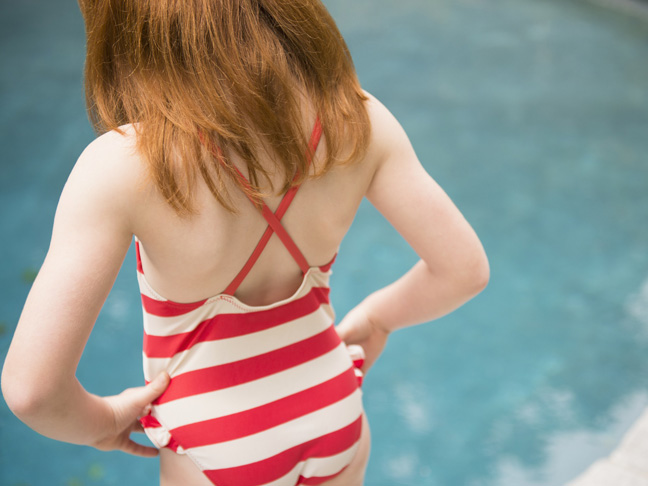I wasn’t thinking about secondary drowning when my family headed to the pool with friends last summer. It was a beautiful Sunday morning, the kind of day meant to be spent at the pool. But then, suddenly, I was faced with the possibility of it. My kids were taking a break from the water and I looked up and saw a crowd gathering. There was loud murmuring and two lifeguards were performing CPR on a child. I quickly passed my baby to my husband and ran. My best friend’s husband, who is also a doctor, was already there. I got down next to him and the lifeguards and we continued the rescue effort. In what seemed like an eternity — but was probably less than two or three minutes — the child’s eyes popped open. He coughed and vomited water. The ambulance arrived. I mentally checked in with myself. He’s okay, he’s alive, I told myself.
I can still see him lying there. It’s an image I don’t think I will ever forget. I have seen sick children in the hospital, but this was different. This was totally unexpected, in a public place with lots of people around. It was a real wake up call. Water safety is a really serious thing. I wondered, Could this happen to my kids? And the truth is, a near drowning, drowning, or secondary drowning incident could happen to anyone. It only takes a few seconds.
You may have heard about secondary drowning or dry drowning in the news or on TV shows (it’s part of the story line on Showtime’s “The Affair,” for example). You may wonder what secondary drowning is and how it can be prevented. The good news is that secondary drowning (which is actually a misnomer but more on that later) is very rare. Here’s what you need to know about the different types of drowning, how to recognize the symptoms of secondary drowning, what to do if you suspect your child is suffering from secondary drowning, and more.
What are the different types of drowning?
Fatal drowning is when the lungs fill with water after a person is submerged in water, and death occurs.
Non-fatal drowning is when a child survives, even for a brief period of time, after being submerged in water. It can lead to what’s commonly referred to as secondary drowning, although the medical community is trying to move away from the term secondary drowning, since it’s more of a delayed drowning.
When does delayed drowning typically occur?
After being briefly submerged in water, an affected child may gag and cough a little but will seem fine for a while. However, the small amount of water that she has aspirated into her airway will spark an inflammatory response, which will cause her lungs to slowly fill with fluid (known as pulmonary edema); that’s why symptoms don’t appear until hours later.
What symptoms should I look out for after a near-drowning event?
Children with underlying lung problems such as asthma, or those with little or no experience swimming, are at slightly higher risk for delayed drowning. If your child exhibits any of these symptoms after a near-drowning event, seek medical help right away:
1. Coughing or breathing difficulties. These problems are the most common symptoms, and they’re not subtle — think frequent and uncontrollable coughing and/or visible shortness of breath. Older children may complain of chest pain.
2. Lethargy or unusual fatigue. It can be hard to tell whether your child is exhausted from a long day in the sun, or it’s something more. When in doubt, err on the side of caution and get medical help.
3. Behavioral changes, or inappropriate behavior. This includes unusual crankiness or irritability in a child. An older child may lose bowel or bladder control.
How are children who develop these symptoms treated?
They should go to the hospital right away. They’ll sometimes need supplemental oxygen; or, if they’re very sick, they may require the insertion of a breathing tube to help them breathe while their lungs have a chance to heal.
How can I help keep my child safe in the water?
1. NEVER leave him unattended in the water, even if a lifeguard is present. ALWAYS keep an eye on your child when he is in the water.
2. Teach your child to swim. According to the American Academy of Pediatrics, children may start swimming lessons as early as age 1; it is recommended that all children over age 4 take swim lessons. But, even children who have taken swimming lessons can still drown. NEVER allow children or adolescents to swim alone.
3. Never use flotation devices in place of adult supervision. Even if your child has a raft, she should be supervised.
4. Take infant and child CPR courses, and have your babysitter take them as well. As your child gets older, you may want to take refresher classes as well.
Sadly, death from drowning is the leading cause of unintentional injury in children ages 1 to 4 and the second most common in children ages 1 to 14. For every child who dies of drowning, there are five children who seek emergency care for non-fatal submersion injuries that can have serious consequences. Luckily, all types of drowning are preventable. The goal of this article is not to scare you, but rather to empower you to be vigilant in preventing drowning and near drowning, know how to handle events if they occur, and know what to look out for in children with near drowning events. As parents, we can help keep our own children — and others — safe in the water.
More from Deena Blanchard, MD:
- How to Get Rid of Head Lice (Yes, Even the Drug-Resistant Kind)
- Spanking Children Is Never OK, Says a Pediatrician & Mom
- 5 Sneaky Ways to Keep Your Kids Healthier This School Year
Photo: Getty








